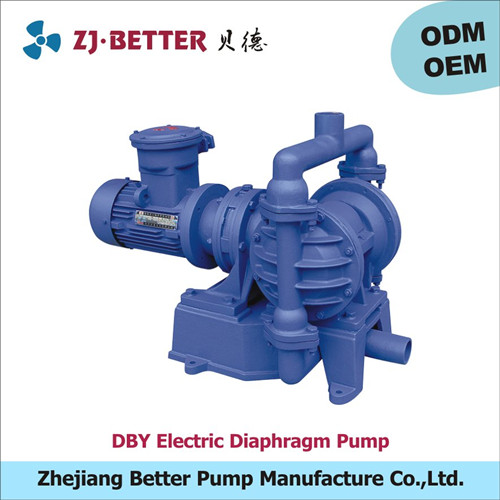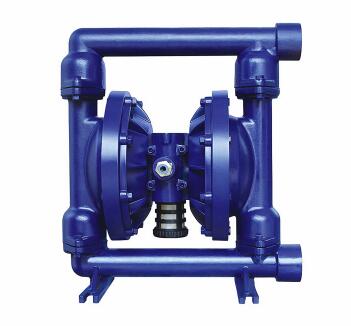The diaphragm pump consists of an actuator and a valve. The diaphragm pump actuators are pneumatic actuators and electric actuators, models are QBY pneumatic diaphragm pumps, QBK pneumatic diaphragm pumps, and DBY electric diaphragm pumps. The main body (valve body) of the diaphragm pump is made of four kinds of materials: plastic, aluminum alloy, cast iron, and stainless steel, which are selected according to the requirements of the liquid or gaseous medium. The diaphragm inside the diaphragm pump is also made of nitrile rubber, neoprene, fluoro rubber, polyvinylidene fluoride, and polytetrafluoroethylene according to different liquid media to meet the needs of different users. It is placed in various special occasions to pump the medium that can not be pumped by conventional pumps and has achieved satisfactory results. Therefore, the type of media should be stated when ordering.
The diaphragm pump selection:
1.The operation mode of the diaphragm pump:
The action mode of the diaphragm pump is only when the pneumatic actuator is selected, and its action mode is formed by the combination of the positive and negative action of the actuator and the positive and negative action of the valve. There are 4 types of combination, namely positive (air-closed), positive and negative (air-open), reverse (air-open), and reverse (air-closed). The diaphragm pump formed by these four combinations has a gas function. Both open and closed. The choice of diaphragm pump action mode is mainly considered in three aspects:
a. process production safety;
b. the characteristics of the medium;
c. Guarantee product quality and minimize economic loss.
2. Selection of flow characteristics of diaphragm pump:
The flow characteristic of the diaphragm pump refers to the relationship between the relative flow rate of the medium flowing through the valve and the displacement (relative opening of the valve). The ideal flow characteristics mainly include four types: straight line, an equal percentage (logarithm), parabola and quick opening. The commonly used ideal flow characteristics are only straight lines, equal percentages (logarithmic), and quick opening. Parabolic flow characteristics are between straight and equal percentages, generally can be replaced by equal percentage characteristics, while fast open characteristics are mainly used in two-position adjustment and program control, so the choice of diaphragm pump characteristics is actually linear and equal percentage flow characteristics. s Choice.
The choice of diaphragm pump flow characteristics can be calculated theoretically, but the methods and equations used are complex. At present, the experience criteria are often used, and the following aspects are considered:
(1) Analysis and selection from the adjustment quality of the adjustment system;
(2) Considering the condition of process piping;
(3) Analysis of load changes.

3. The choice of diaphragm pump caliber:
The choice and determination of the diameter of the diaphragm pump are mainly based on the flow capacity of the valve, ie cv. In the design and selection of instruments for various projects, the diaphragm pump must be cv calculated and the diaphragm pump design specification provided. From the calculation of the cv of the diaphragm pump to the determination of the diameter of the valve, the following steps are generally required:
a Calculate the determination of traffic. The existing production capacity, equipment load and the condition of the medium determine the qmax and qmin of the calculated flow.
b. Determination of the differential pressure before and after the valve. The s (resistance coefficient) is selected according to the selected valve flow characteristics and system characteristics, and then the calculated differential pressure is determined.
c. Calculate cv. Select the appropriate calculation formula and graph according to the adjusted medium, and find cmax and cmin.
d. choose cv. According to cmax, select >cmax and the closest level c. in the selected product standard series.
e. diaphragm pump opening degree check. Generally, the opening degree of the maximum calculation flow rate is ≯90%, and the opening degree when calculating the minimum flow rate is ≮10%.
f. Check the actual adjustable ratio of the diaphragm pump. Generally, the actual adjustable ratio ≮10 is required.
g, determination of seat diameter and nominal diameter. After verification is appropriate, determine according to c.
4.The choice of diaphragm pump type
(1) Valve body type selection of diaphragm pump
The choice of the valve body is the most important part of diaphragm pump selection. There are many types of diaphragm pump bodies. There are 10 types of single-seat, straight-through two-seat, angle, diaphragm, small flow, three-way, eccentric rotation, butterfly, sleeve, and spherical. Before selecting the valve, carefully analyze the media, process conditions and parameters of the control process, collect sufficient data, understand the system requirements for the diaphragm pump, and determine the type of valve to be used based on the collected data. In the specific choice, you can consider the following aspects:
a. Abrasion resistance When the fluid medium is a suspension containing a high concentration of abrasive particles, the valve core, and the valve seat joint face are severely rubbed each time they are closed. Therefore, the flow path of the valve should be smooth and the internal material of the valve should be hard.
b. Corrosion resistance Because the medium is corrosive, in the case of meeting the adjustment function, try to choose a simple valve.
c. The shape of the valve core is mainly considered according to the selected flow characteristics and unbalanced forces.
d. Temperature and pressure of the medium When the temperature and pressure of the medium are high and the change is large, the valve and the material of the valve seat should be selected to be small in temperature and pressure.
e. Prevent flashing and cavitation flashing and cavitation only in liquid media. In the actual production process, flashing and cavitation not only affect the calculation of the flow coefficient but also form vibration and noise.

(2) Selection of diaphragm pump actuator
a, the output force considerations
Regardless of the types of hydraulic actuators, its output force is the effective force to overcome the load (mainly refers to the unbalanced force and unbalanced torque plus the friction, sealing force, gravity and other related forces). Therefore, in order for the diaphragm pump to work properly, the actuator used should generate sufficient output force to overcome various resistances, ensuring high sealing and opening of the valve.
For double-acting pneumatic, hydraulic, and electric actuators, there is generally no return spring. The magnitude of the force is independent of its direction of travel. Therefore, the key to selecting an actuator is to clarify the maximum output force and the rotational torque of the motor. For single-acting pneumatic actuators, the output force is related to the opening of the valve, and the forces appearing on the diaphragm pump will also affect the motion characteristics, thus requiring a force balance across the diaphragm pump’s opening range.
b. Determination of the type of actuator
After determining the output force of the actuator, select the corresponding actuator according to the requirements of the process environment. For explosion-proof requirements on site, pneumatic actuators should be used, and the junction box is explosion-proof, and electric actuators cannot be selected. If there is no explosion-proof requirement, pneumatic and electric actuators can be used, but in terms of energy saving, electric actuators should be selected as much as possible. For hydraulic actuators, the use is not as extensive as pneumatic and electric actuators, but it has the characteristics of high adjustment precision, fast and stable movement. Therefore, in some cases, in order to achieve better adjustment effect, hydraulic actuation must be selected. Institutions, such as speed regulation of power plant transparent machines, temperature regulation control of refinery catalytic converters, etc.